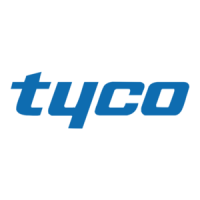Tyco Electronics Galaxy SC Controller J85501F-1
Issue 13 February 2001 T1.317 Interface Appendix A - 5
Operation
Commands
Operation commands change the state of the system. Listed below are
the commands, description, syntax, and the operations those commands
perform.
ADD Add a user addable object to the system.
Add a linkable attribute to an object.
ALI Assign a command line an alias.
BYE Terminate a session.
CHA Change the value of an attribute.
CLE Clear an event.
CLH Clear history.
CLS Clear statistics.
DEL Delete a user addable object from the system.
Delete a linkable attribute from an object.
ECHO Echo the following text.
LIN Link an object to a linkable attribute.
LOGIN Login at a security level.
OPE Change the state of special operational attributes.
PAGE Set the command response page size for the current session.
PAS Change a password.
REM Remark
RSDATE Interactively set the system date and time.
UNL Unlink an object from a user linkable attribute.
BACKUP Backup the system configuration.
RESTORE Restore the system configuration.
UPGRADE Upgrade the intelligent controller software.
All commands return a minimal response of .<CR><LF>
(period-carriage return-line feed). This command complete response is
an acknowledgment that the command was received and processed. If an
error occurred while processing the command then a line preceded by
the ! (exclamation) character will give an error code and short
description of the error.
ADD Add an object to the system
Syntax: ADD objtype
ADD objtype,objid[,”description”]
When adding an object to the system objtype must be one of the following:
DRC for derived channels
TL1 for TL1 interface objects
TME for timer events
UDE for user-defined events
UDO for user-defined objects
For user-defined objects, objid may be any identifier that does not conflict with
one of the system reserved object identifiers. For other objects, objid must one
of the identifiers reserved for that type of object.
If objid is omitted the system will pick the next reserved object identifier auto-
matically. That chosen identifier will be reported by
the command. The description is optional and will be assigned as the value of
the object’s DES attribute. If description is omitted then a default description
will be given to the new object. The following example adds the user-defined
event identified as U0001 to the system:
ADD UDO,U0001
ADD Add a linkable attribute to an object
Syntax: ADD objid,attrl

